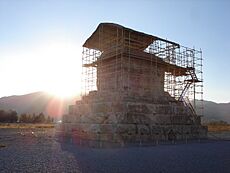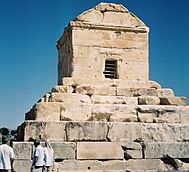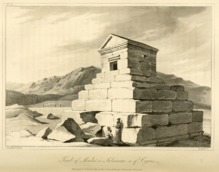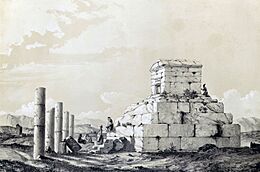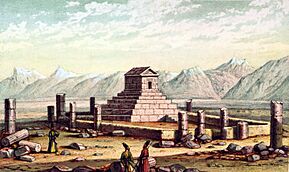Tomb of Cyrus the Great facts for kids
Quick facts for kids Tomb of Cyrus the Greatآرامگاه کوروش بزرگ |
|
|---|---|
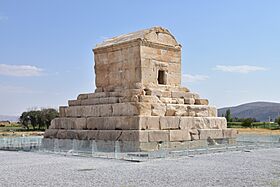 |
|
| Location | Pasargad, Iran |
| Built | 6th century BC |
| Built for | Cyrus the Great |
| Architectural style(s) | Persian (Achaemenid) |
| Lua error in Module:Location_map at line 420: attempt to index field 'wikibase' (a nil value). | |
The Tomb of Cyrus the Great (Persian: آرامگاه کوروش بزرگ, Ârâmgâh-e Kuroš-e Bozorg) is the final resting place of Cyrus the Great. He was the founder of the ancient Achaemenid Empire. This important tomb is located in Pasargad, an ancient site in the Fars Province of Iran.
This tomb is a great example of how ancient people built strong buildings. It is thought to be the oldest structure designed to handle earthquakes. This special design helps it stay safe during ground shaking. The tomb is a key part of the Iranian UNESCO World Heritage Sites at Pasargadae.
Contents
Finding the Tomb
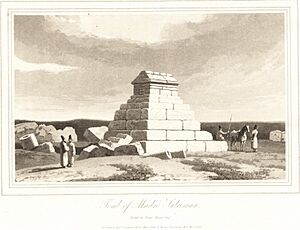
For a long time, people called this tomb the Tomb of Madre Suleiman. This name might have referred to a caliph or a biblical queen. In the early 1800s, explorers like James Justinian Morier and Robert Ker Porter suggested it was Cyrus's tomb.
Morier compared the building to descriptions by the Greek historian Arrian. He noticed many similarities, even though some small details were different. For example, Arrian mentioned an inscription that was no longer there. But Morier believed this was indeed the famous tomb of Cyrus.
How the Tomb Was Built
The Tomb of Cyrus is found in the southern part of Pasargadae. It was once part of the royal park. The tomb is made from yellowish-white limestone. This stone likely came from the Sivand mine nearby.
This building has stood strong for 2,500 years. It has survived many natural events. The tomb has two main parts. First, there is a stone platform with six steps. On top of the sixth step is a room with a sloped roof.
The whole building is about 11 meters tall. The first step is about 165 centimeters high. The next two steps are each about 105 centimeters high. The top three steps are each about 57.5 centimeters high. The platforms are about half a meter wide.
The tomb room itself is about 3.17 meters long and 2.11 meters wide. It is also 2.11 meters high inside. The walls are very thick, up to 1.5 meters. They are made of four rows of well-cut stones. The entrance used to have a sliding double door. Today, the opening is 78 centimeters wide and 140 centimeters high.
Above the entrance, there used to be a beautiful flower design. A traveler named Johann Albrecht von Mandelslow drew it in 1638. Later, in 1964, David Stronach studied and explained this design.
The roof of the tomb is flat on the inside. But on the outside, it has a gabled or sloped shape. This roof is made of two large stones. There was once another stone on top, but it is now gone. People believe the builders made a hollow space inside the roof. This was to make the heavy stones lighter and easier to move. Some old accounts suggest this hollow space might have been a burial spot.
The floor of the tomb room has two large stone slabs. In the 1800s, people noticed holes in these slabs. They thought someone might have dug there to see what was underneath.
The tomb was built without mortar, which is like glue for stones. Instead, metal clamps held the stones together. Over time, many of these metal clamps were removed. This left holes and weakened the building. Later, a team led by Alireza Shapour Shahbazi repaired these damaged areas.
What Was Around the Tomb
Visitors in the 1800s wrote about columns around the tomb. Today, there are no signs of these columns or other structures. For example, a German scholar named Franz Heinrich Weisbach described 22 columns. They surrounded three sides of the tomb. He also mentioned walls around these columns.
Another visitor, Kerr Porter, saw the tomb in 1818. He said a large area was enclosed by 24 round pillars. He noted that 17 pillars were still standing. These accounts help us imagine what the area looked like long ago.
Repairing the Tomb

The tomb has been repaired twice in recent times. The first time was in 1972. This was to get it ready for the 2,500-year celebration of the Persian Empire. The second repair happened between 2002 and 2009.
Some experts have said that the roof was badly damaged during the second repair. They mentioned that the person in charge of the repair might not have had enough scientific training. They believed the work should have taken longer to do correctly.
Ancient Descriptions of the Tomb
The most detailed description of the tomb comes from Arrian. He wrote about it in the 2nd century AD. His information came from Aristobulus of Cassandreia, who traveled with Alexander the Great.
Arrian wrote that the tomb was in a royal park with many trees. A stream watered the area. The tomb's base was made of squared stones. On top was a stone building with a narrow door. Inside, there was a golden coffin with Cyrus's body. There was also a golden couch and beautiful carpets. Other valuable items like clothes, jewelry, and a table were also inside.
Arrian also mentioned an inscription on the tomb. It said: "O man, I am Cyrus, son of Cambyses, who founded the empire of the Persians, and was king of Asia. Do not therefore grudge me this monument.”
Strabo, another ancient writer, also described Alexander the Great's visit. He said Alexander found a golden bed, a table with cups, and a golden coffin. However, when Alexander visited again, the tomb had been robbed. Only the broken couch and coffin remained. This showed that robbers, not officials, had taken the treasures. Magi, who were priests, guarded the tomb. They received food and a horse each month for their duty.
Tomb Design
The design of Cyrus's tomb might have been inspired by ancient buildings. Some think it looks like ziggurats from Mesopotamia or Elam. The main room, called a cella, might be like older tombs from Urartu.
Interestingly, the tomb at Pasargadae is very similar in size to the tomb of Alyattes of Lydia. Alyattes was the father of King Croesus. Croesus was spared by Cyrus when Persia conquered Lydia. He later became part of Cyrus's court. The main decoration on the tomb is a rosette design above the door.
Cyrus the Great Day

Cyrus the Great Day is an unofficial holiday in Iran. It happens every year on October 29. This day celebrates Cyrus the Great. It marks the anniversary of Cyrus entering Babylon. Cyrus founded the first Persian Empire, also known as the Achaemenid Empire.
Buildings Like the Tomb
It seems that the Tomb of Cyrus was a unique building when it was first built. No other buildings exactly like it existed before. However, similar structures were built later.
One such building is Gur-e-Dokhtar. It is in the Bushehr Province of Iran. This ancient monument looks very much like Cyrus's tomb. Some experts, like Alireza Shapour Shahbazi, believe it might be the tomb of Cyrus I, an earlier king.
There is also a similar building in Taş Kule, Sardis. This was likely built when Lydia was part of the Achaemenid Empire. It might have been for an important Persian or Lydian person.
Iranian New Year Celebrations
During Nowruz, which is the Persian New Year, people gather at the tomb. Iranians from all over the country come to celebrate. They honor Cyrus the Great as the founder of Iran and the Persian Empire.
Gallery
-
A drawing of the tomb by Robert Ker Porter, 1818.
-
Gur-e-Dokhtar, a similar tomb that might belong to Cyrus I.
-
The Tomb of Cyrus the Great on the back of a 1938 500 Rials banknote.
-
The Tomb of Cyrus the Great on the back of a 1970s 50 Rials banknote.
See also
- Gur-e-Dokhtar
- 2016 Cyrus the Great Revolt


